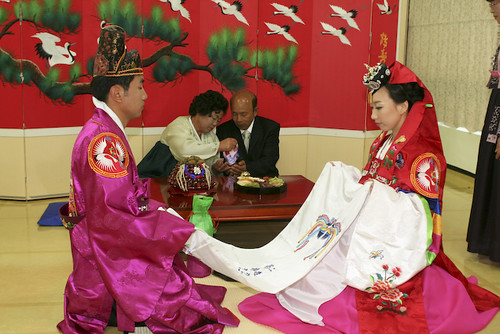

Like the Chinese, Koreans also exchanged the "eight characters" or "four pillars" to determine if the match was suitable. When that process was over, a local fortune-teller was summoned to see if the couple could live harmoniously. Koreans call this kung-hap. This custom is still important among many older Korean Americans. As the old saying goes, straw sandals are useful only if they fit your feet.
The Engagement
Gifts are an important part of an engagement. Traditionally, gifts from the groom's side would be delivered on the eve of the wedding day. With faces blackened with dried squid's ink and in costume, friends of the groom would parade a box, or hahm, filled with gifts. As they approached the bride's house, they would chant, "Hahm for sale, buy a hahm." Her family would rush out to greet the gift-bearers, enticing them with money and food. These days, the families are likely to meet in a restaurant, but gifts--and lots of them--are a must. Some Korean American families can spend $30,000 to $40,000 on engagement gifts alone.
The Wedding Outfits
The two dresses worn by the bride were once the costume of the noble class. The simple lime-green wonsam and the more elaborate hwarrot, or "flower robe," are embroidered with flowers and butterflies. Underneath, she wears the hanbok, the doll-like traditional dress of Korea. On the bride's head is a black cap studded with gems. On her feet are white socks and embroidered shoes. Her makeup is simple, except for three red circles, yonji konji, the size of nickels. These circles, traditionally made of red peppers, but now often drawn on, are supposed to ward off evil spirits. The groom's faruotsu is also the dress of the nobility. It is made of dark green damask with auspicious symbols woven in gold. The headdress is the tall black cap of high-ranking officials made of silk. Traditional costumes can be rented in Korean dress shops or even some banquet halls starting around $150.
The Ceremony
Traditionally, the groom would give a live goose--a symbol of fidelity because it takes only one partner in its life--to his new mother-in-law as a sign of his faithfulness to her daughter. Today's Korean families substitute the live goose with a wooden one called a kirogi. The ceremony takes place around a table, or teresan, in an area set off by a screen with images of peonies. The highlight of the ceremony is the sharing of a special white wine called jung jong. Traditionally, this wine was poured into cups made from two halves of a gourd grown by the bride's mother. The bride and groom sip from their separate cups and then the wine is mixed together, poured once more into the gourd cups and sipped again. This is kunbere, the wedding vow. One ritual often seen at Korean American weddings is the peh beck ceremony. At this ceremony, usually only attended by family and close friends, the new wife offers her new in-laws gifts of dried dates and jujubes, symbols of children. They in turn offer her tea, a subtle but significant gift. At the ceremony's conclusion, they toss the dates and chestnuts at the bride, and she tries to catch them in her large skirt.
The Food
The Korean wedding banquet is called kook soo sang, the "noodle banquet," and can include a variety of dishes to suit the season. It begins with a toast of jung jong, a sort of Korean sake, downed quickly like a shot. The highlight is the meal's namesake, a noodle soup called kook soo. Wheat noodles are boiled and added to a clear beef broth, garnished with vegetables and eggs. Here, as in China, noodles are a wish for a long and happy life. Wedding desserts often include dok, a sticky rice cake that comes in a number of forms--sweetened, filled with bean paste, dotted with sesame seeds. Another popular dessert is yak shik, a sticky rice ball sweetened with brown sugar and speckled with chestnuts, jujubes, raisins and pine nuts, symbols of children.
Source : http://www.weddingsatwork.com/culture_customs_korean.shtml




